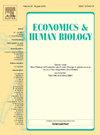Towering Intellects? Sizing up the relationship between height and academic success
IF 1.8
3区 医学
Q2 ECONOMICS
引用次数: 0
Abstract
Do tall students do better in school? A robust literature documents higher earnings among taller people and suggests that differences in adult labor market outcomes may reflect prior differences in academic outcomes. In this paper, we use unique student-level longitudinal data from New York City (NYC) to examine the link between height and achievement, shedding light on underlying mechanisms. The centerpiece of our empirical work is a regression linking test scores to height, measured as a z-score normalized to same grade/sex peers within schools. We estimate a meaningful height gradient for both boys and girls in English Language Arts (ELA) and math achievement in all grades 3–8. Controlling for observed student characteristics, a one standard deviation (sd) increase in height for grade is associated with .03 and .039 sd higher performance in math and ELA, respectively, for boys and .034 and .04 sd in math and ELA, respectively, for girls. While the average gradient is small in magnitude, it is sufficiently large to generate meaningful differences in achievement between the tallest and shortest students. For example, the tallest 2.5 % boys and girls within grade perform .18 and .194 sd better in ELA, respectively, than the shortest ones. We also find evidence that ordinal height rank relative to peers may have a small effect on ELA achievement conditional on cardinal height. Thus, there is an academic height premium for both absolute and relative height.
高耸的智力吗?评估身高和学业成绩之间的关系
高个子的学生在学校表现更好吗?大量文献证明高个子的人收入更高,并表明成人劳动力市场结果的差异可能反映了先前学术成果的差异。在本文中,我们使用来自纽约市的独特的学生水平纵向数据来检验身高与成就之间的联系,揭示潜在的机制。我们实证工作的核心是将考试成绩与身高联系起来的回归,以z分数衡量,标准化到学校内的同年级/性别同龄人。我们估计在所有3-8年级的英语语言艺术(ELA)和数学成绩中,男孩和女孩都有一个有意义的身高梯度。控制观察到的学生特征,一个标准偏差(sd)的身高增加与年级有关,男孩的数学和语文成绩分别提高0.03和0.039个标准差,女孩的数学和语文成绩分别提高0.034和0.04个标准差。虽然平均梯度的大小很小,但它足以在最高和最矮的学生之间产生有意义的成绩差异。例如,年级内最高的2.5 %的男孩和女孩在ELA上分别比最矮的男孩和女孩高0.18和0.194 sd。我们也发现证据表明,相对于同伴的顺序身高排名可能对以基数身高为条件的ELA成绩有较小的影响。因此,无论是绝对身高还是相对身高,都有学术身高溢价。
本文章由计算机程序翻译,如有差异,请以英文原文为准。
求助全文
约1分钟内获得全文
求助全文
来源期刊

Economics & Human Biology
医学-公共卫生、环境卫生与职业卫生
CiteScore
4.50
自引率
12.00%
发文量
85
审稿时长
61 days
期刊介绍:
Economics and Human Biology is devoted to the exploration of the effect of socio-economic processes on human beings as biological organisms. Research covered in this (quarterly) interdisciplinary journal is not bound by temporal or geographic limitations.
 求助内容:
求助内容: 应助结果提醒方式:
应助结果提醒方式:


